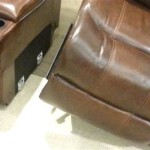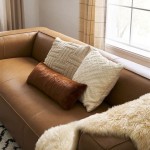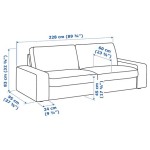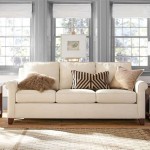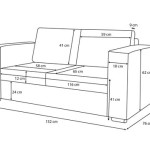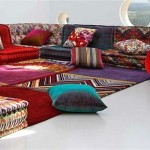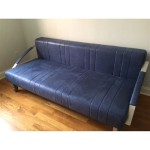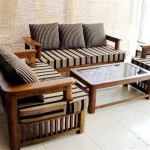Adding Legs to a Sectional Sofa: Considerations for Costa Rica Residents
Sectional sofas are a popular choice for homeowners, offering versatility and ample seating space. However, many sectional sofas are designed to sit low to the ground, a feature that may not suit everyone's preferences or needs. Adding legs to a sectional sofa can improve its aesthetic appeal, enhance comfort, and simplify cleaning. For Costa Rica residents, several factors should be considered before undertaking this project, accounting for local availability of materials, climate considerations, and common housing styles.
This article explores the various aspects of adding legs to a sectional sofa, focusing on practical considerations for residents in Costa Rica. These considerations will help ensure the successful and aesthetically pleasing transformation of a sectional sofa, tailored to the specific context of Costa Rican homes.
Assessing the Suitability of the Sectional Sofa
Before investing time and resources into adding legs, it is crucial to evaluate the suitability of the sectional sofa for this modification. Not all sectional sofas are structurally designed to accommodate added legs. The sofa's frame must be robust enough to bear the weight of the sofa and its occupants when elevated. Inspect the underside of the sofa to identify existing support beams or framing. Ideally, the legs should be attached directly to these structural elements for maximum stability.
The existing upholstery should also be considered. If the fabric or leather is tightly fitted and extends far underneath the sofa, adding legs might create unsightly gaps or require alterations to the upholstery. Furthermore, consider the overall style of the sectional sofa. Adding modern, sleek legs to a traditional, overstuffed sectional might create a visual mismatch. The style and finish of the legs should complement the existing design elements of the sofa.
Finally, consider if the sectional sofa is modular and if each section has its own independent base. This would mean each section needs its own leg structure and installation. If the sections are designed to interlock and share structural support, the leg installation needs to account for this integrated design to maintain stability.
Selecting Appropriate Legs for the Sectional Sofa
The choice of legs is paramount to the success of this project. The material, height, style, and attachment method all influence the final outcome. In Costa Rica, considerations like humidity and termite resistance should influence material selection. Hardwoods like teak or cedar, which are commonly available in Costa Rica and resistant to moisture and pests, are suitable choices. Metal legs, particularly those treated with rust-resistant coatings, are also viable options, especially in coastal regions.
The height of the legs determines the elevation of the sofa. Consider the desired level of comfort and the existing furniture in the room. Standard sofa leg heights range from 4 to 8 inches. A higher elevation might be preferred for individuals with mobility issues, facilitating easier sitting and standing. Ensure the chosen height complements the height of coffee tables and other seating in the living room. Measure the existing furniture carefully to ensure the new legs will result in a harmonious arrangement.
The style of the legs should harmonize with the sectional sofa's overall aesthetic. Options range from simple, tapered wooden legs to ornate, carved designs. Sleek, modern metal legs can provide a contemporary contrast to a traditional sofa. Consider the existing hardware in the room, such as cabinet pulls and light fixtures, and select legs that complement these elements. A cohesive design aesthetic enhances the overall appeal of the space.
The attachment method is another critical factor. Legs can be attached using various methods, including screws, bolts, threaded inserts, or mounting plates. The chosen method should provide a secure and stable connection between the leg and the sofa frame. Mounting plates distribute the weight more evenly and are often preferred for heavier sectional sofas. Ensure the mounting hardware is appropriate for the type of material the sofa frame is made of. Using incorrect screw types can compromise the frame integrity.
Addressing Practical Considerations in Costa Rica
Specific factors related to Costa Rica need to be considered during the planning and execution stages. The availability of materials and tools can influence the project's feasibility. While hardwoods like teak and cedar are readily available, specialized hardware or furniture legs might need to be sourced from larger hardware stores or ordered online.
Humidity is a significant factor in Costa Rica. Wood legs should be properly sealed and treated to prevent moisture absorption and warping. Metal legs should be coated with rust-resistant paint or powder coating. Regular maintenance, such as applying furniture polish or rust inhibitor, can extend the lifespan of the legs.
Termites and other pests are prevalent in Costa Rica. When using wood legs, ensure they are treated with a termite-resistant solution before installation. Regularly inspect the legs for signs of infestation and take appropriate measures if necessary. Consider using pressure-treated wood for added protection.
The construction style of homes in Costa Rica can also influence the choice of legs. Many homes are built on concrete slabs, which can present challenges for attaching legs. Ensure the legs are securely anchored to the frame of the sofa and that the weight is evenly distributed. Consider using wider legs or mounting plates to provide additional stability. In homes with wooden floors, protect the flooring from scratches by using felt pads or rubber feet on the bottom of the legs.
The voltage for power tools in Costa Rica is generally 110V at 60Hz. Ensure the tools used for installation are compatible with this voltage. Using incorrect voltage can damage the tools and pose a safety hazard. Also, be sure to use the correct type of electrical outlet and grounding for power tools, following local electrical codes.
Step-by-Step Installation Guide
Once the appropriate legs have been selected and the necessary preparations have been made, the installation process can begin. This section outlines a general step-by-step guide. However, specific instructions may vary depending on the type of legs and the construction of the sectional sofa.
Step 1: Prepare the Workspace. Clear the area around the sectional sofa and protect the flooring with drop cloths or cardboard. Gather all necessary tools and materials, including the legs, mounting hardware, drill, screwdriver, measuring tape, level, and marking pencil.
Step 2: Position the Sectional Sofa. Carefully turn the sectional sofa upside down, ensuring it is resting securely on a stable surface. Use padding to protect the upholstery from damage. If working with a modular sectional, address each section individually.
Step 3: Mark the Leg Locations. Use a measuring tape and marking pencil to determine the desired location for each leg. Ensure the legs are evenly spaced and aligned with the sofa's frame. If the sofa has existing support beams, align the legs with these structural elements.
Step 4: Attach the Mounting Plates (if applicable). If using mounting plates, position them on the marked locations and secure them to the sofa frame using screws or bolts. Ensure the mounting plates are flush with the frame and that the screws or bolts are tightened securely.
Step 5: Attach the Legs. Attach the legs to the mounting plates or directly to the sofa frame, depending on the chosen attachment method. Use a drill or screwdriver to tighten the screws or bolts. Ensure the legs are securely attached and that they are aligned properly.
Step 6: Check for Stability. Once all the legs have been attached, carefully turn the sectional sofa upright. Check for stability by gently rocking the sofa. If any legs are loose or wobbly, tighten the screws or bolts. Use a level to ensure the sofa is sitting evenly.
Step 7: Make Adjustments. Adjust the legs as needed to ensure the sofa is stable and level. If the sofa is sitting on an uneven floor, use shims under the legs to compensate for the unevenness.
Step 8: Final Inspection. Conduct a final inspection to ensure all legs are securely attached and that the sofa is stable and level. Clean up the workspace and remove any debris.
By carefully considering these factors and following a step-by-step installation guide, residents in Costa Rica can successfully add legs to their sectional sofas, enhancing their comfort, style, and functionality.

Y 136 Wide Corner Sectional Sofa Adjustable Backrest Sof Relyksliving

Modular Sectional Sofa Couch L Shaped Corner Set Komfott

Mjkone L Shape Reversible Modular Sectional Sofa With Ottoman
Shintenchi Convertible Sectional Sofa Couch Modern Linen Fabric L Shaped 3 Seat With

Reversible Modular Corner Sectional Sofa Excellent Group Furniture

Mjkone L Shape Reversible Modular Sectional Sofa With Ottoman

Sugars Glacier Sectional Adcock Furniture Design

Costa Rica Corner Sectional Set Aeon Furniture

Na L Shape Sectional Sofa For Your Modern Living Room Relyksliving

Modular Sectional Sofa Couch L Shaped Corner Set Komfott

